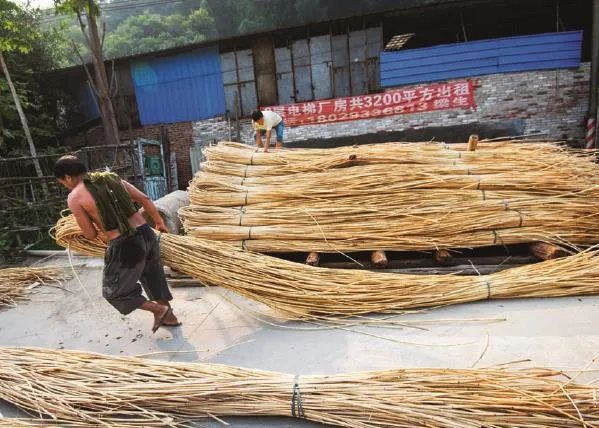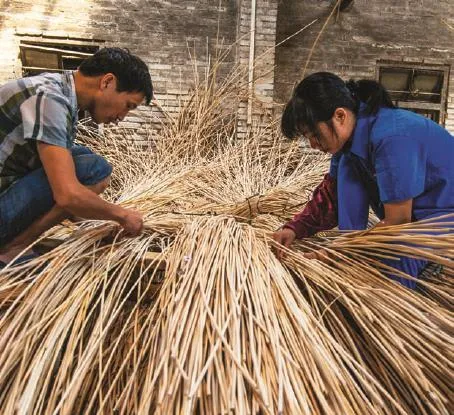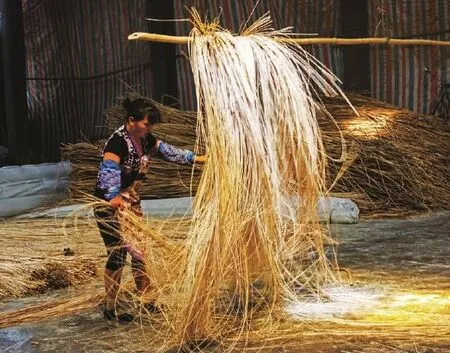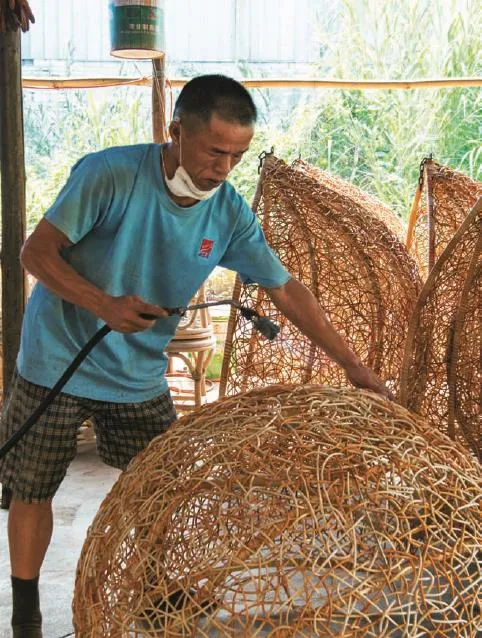RATTAN WEAVING IN NANHAI
2016-09-22PHOTOGRAPHSBYMENGQINGCHUN孟庆春
PHOTOGRAPHS BY MENG QINGCHUN (孟庆春)
TEXT BY SUN JIAHUI (孙佳慧)
RATTAN WEAVING IN NANHAI
PHOTOGRAPHS BY MENG QINGCHUN (孟庆春)
TEXT BY SUN JIAHUI (孙佳慧)
Traditions persist in China’s wicker capital
“藤编之乡”广东南海:流淌于指尖的素雅与精巧
Cozy and functional, natural wicker furniture has been the style of choice for millennia—a method of crafting rigid plant stalks, branches, or shoots to form household furniture that can last through the ages. And, for malleability and reliability, there is no better medium than rattan.
Nanhai (南海), a district in Foshan City, Guangdong Province, is known as the “Land of Rattan Weaving” (藤编之乡). To some extent, the rattan weaving of Nanhai is so common that it’s more of a career choice than a traditional handicraft.
When you enter any of the rattan-weaving factories of Nanhai, you’ll find workers and their wicker at busy machines, crafting some of the finest rattan works in the world. Whether they’re crafting furniture or artworks, the job itself is not one that demands many requirements. After some simple training, new laborers join in the manufacturing process and are paid on a piecework basis, which might sound bad, but it ends up being far above the local salaries that low-skilled workers can find in the area. As long as workers put in the hours, it’s a secure, comfortable position. Children can often be found in the factories, accompanied by their busy parents, and some might even pitch in to make a little extra holiday money.
Rattan weaving has a long Chinese history that can be traced back more than 2,000 years. Rattan remnants of bags and baskets have been found dating back to the Warring States period (475 BCE - 221 BCE). At the time, Li Bing, a Chinese administrator and engineer, who was in charge of preventing floods, asked people to build dams with rattan baskets full of rocks to control the water.
As rattan is both pliable and tough, it was also made into shields for the battlefield. When it came to the Tang Dynasty (618 - 907), weaving techniques had improved to an art form and people could weave complex curtains patterned with different kinds of flowers, birds, fish, and insects.
It wasn’t until the Ming (1368 - 1644) and Qing (1644 -1911) dynasties that rattan weaving would truly mature as an industry. Rattan furniture and household goods became very popular, especially in the areas around Guangzhou. According to Guangdong Xin Yu (《广东新语》), a work of chorography written by Qu Dajun (屈大均) in the Qing Dynasty, in Lingnan—a region encompassing the modern Chinese provinces of Jiangxi, Hunan, Guangdong, Guangxi, and Hainan—“Of every ten households, there would be two weaving rattan.” (其织作藤器者,十家而二。)
However, in the modern day, the rattan-weaving industry seems to have met with subtle embarrassment. As factory furniture can be churned out made of pretty much anything, rattan furniture is fighting to survive. However, it is a traditional industry the local government is trying to keep alive, and the Nanhai authorities opened rattanweaving training schools in an attempt to maintain and hand down this traditional craft—even though it didn’t exactly take off. However, rattan weaving is not a dying art. The industry is stable and will probably stay that way for a long time to come. For us, it’s just a cheap furniture option, but for the people of Nanhai, it’s a way of life—one they take great pride in.

A WORKER DRAGS A HEAP OF WICKER TO HIS WORKSTATION

WORKERS CHOOSE WICKER RATTAN STEMS BASED ON THEIR THICKNESS

IF THE THICKNESS IS NOT EXACT, MACHINES ARE USED TO CUT THEM INTO THE PERFECT DIAMETER

RATTAN CANES MUST BE SORTED BEFORE THEY CAN BE HANGED AND MADE READY FOR THE PRODUCTION PROCESS

DELICATE WEAVING IS STILL DONE BY HAND AND WITH THE ASSISTANCE OF A SMALL METAL TOOL

CURTAINS, RATHER THAN FURNITURE, ARE ONE OF THE MOST POPULAR RATTAN PRODUCTS

WORKING PARENTS ARE USUALLY ALLOWED TO BRING THEIR KIDS TO THE FACTORY WHERE THEY CAN BE LOOKED AFTER

THOUGH NOT AS POPULAR AS FURNITURE OR CURTAINS, THERE IS CERTAINLY A DEMAND FOR CHARMING RATTAN ARTWORKS

ADDING DECORATION TO THE WORKS IS THE LAST STEP BEFORE THESE RATTAN PIECES FIND THEIR WAY TO MARKET
